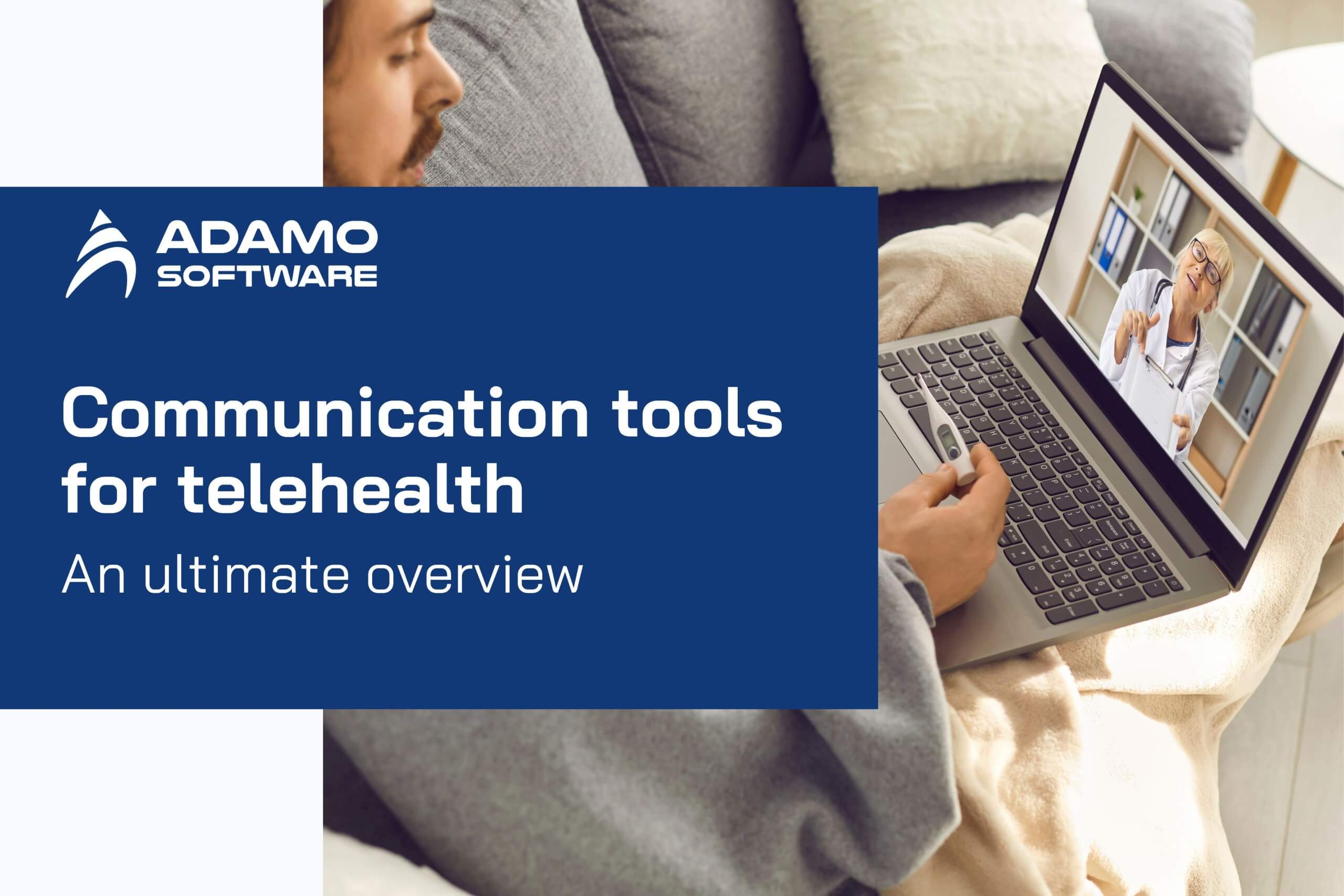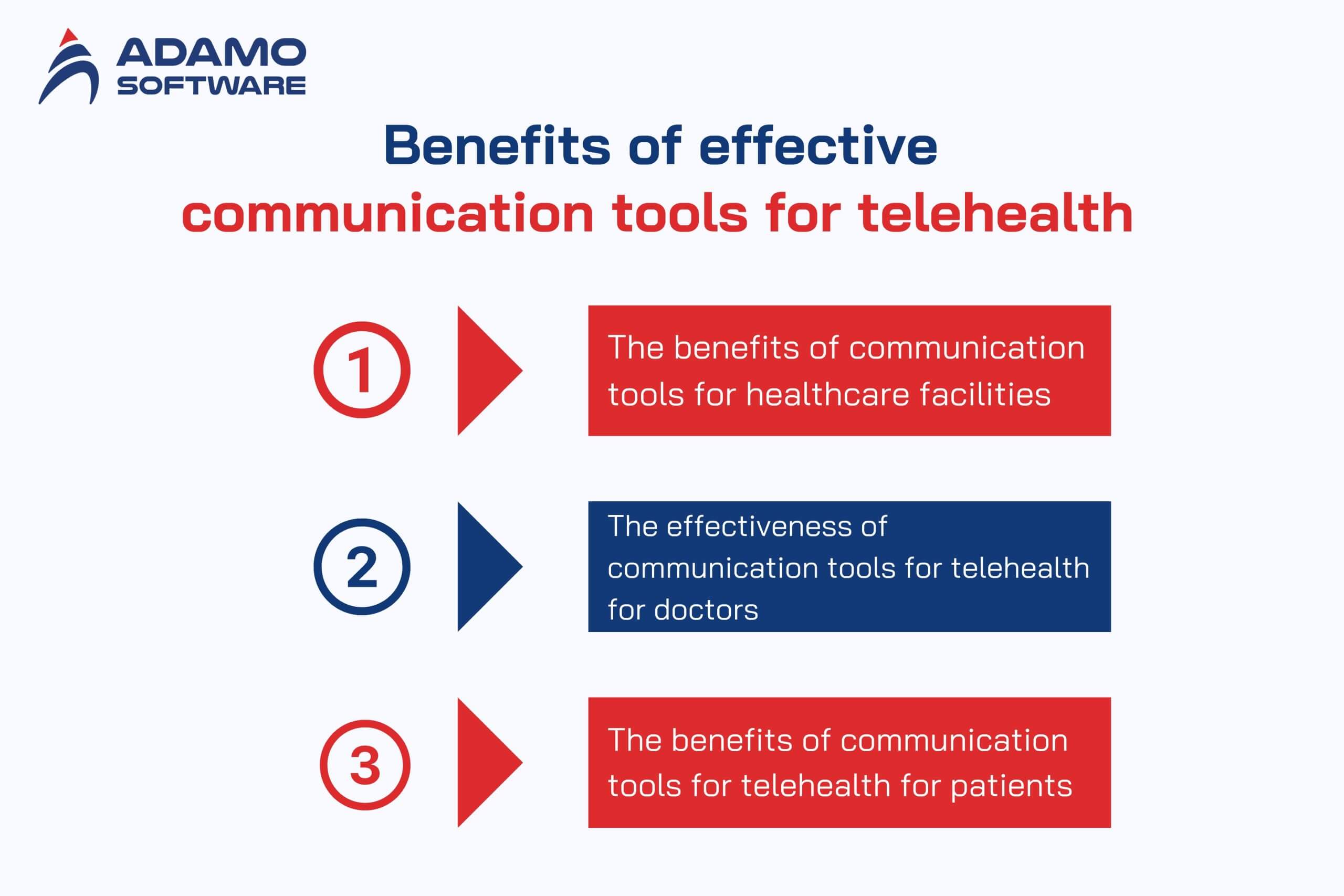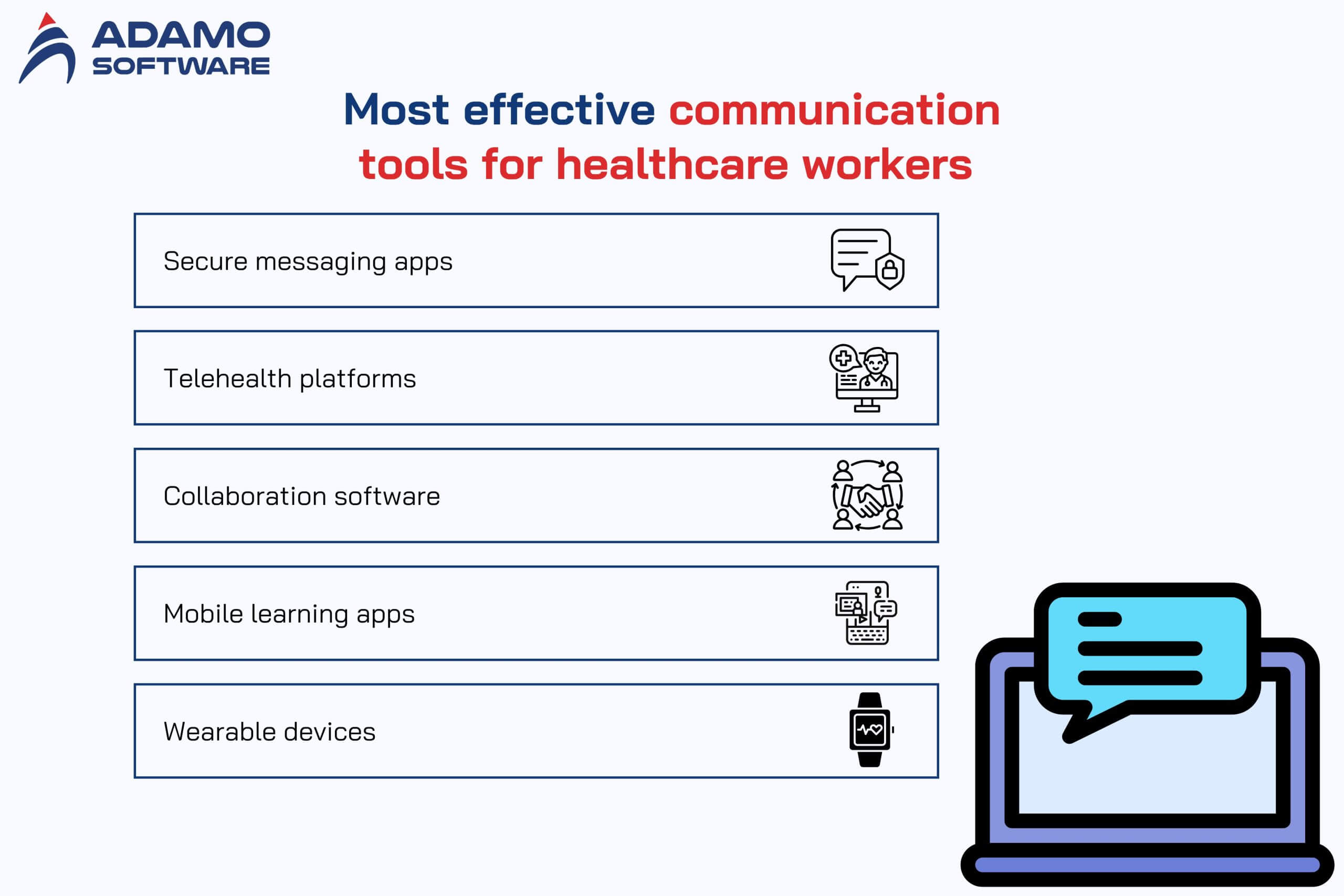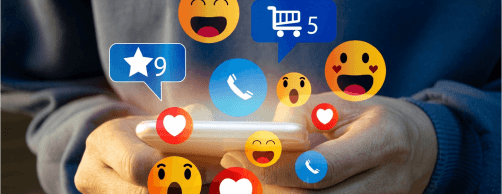Communication tools for telehealth: An ultimate overview

Communication channels play an important role in remote treatment. Let’s learn about communication tools for telehealth with Adamo Software!
Telehealth has become popular for patients, which allows them to receive remote medical examination and treatment services instead of going directly to the healthcare facilities. Communication channels play an important role in supporting these services, helping patients connect with medical staff. By choosing suitable tools, healthcare facilities can maintain the quality of telemedicine services and communication effectiveness. So, which communication tools for telehealth that medical centers can use? Let Adamo Software answer this question.
Through this blog post, you will find detailed information on the two main types of communication tools for telehealth, benefits of these tools, and some most effective communication tools for healthcare workers. Besides, you will also know the top 7 communication tools for telehealth to consider. All of the information has been thoroughly researched and updated to the latest trends. So, let’s read our post and find useful information for you!
I. Two main types of communication tools for telehealth
The communication tools for telehealth are divided into two main types. They are synchronous tools and asynchronous tools. Each type of the tool can be used in different situations with distinctive functions. Let’s explore each type with Adamo Software!
1. Synchronous type of communication tools for telehealth
Thanks to the synchronous communication tools for telehealth, doctors and patients can exchange information in real time. Besides, they facilitate immediate consultations and diagnosis. They require two parties to participate in the communication at the same time, creating an interactive experience like they are meeting face to face directly. Below are some cases of using this type of communication tool for telehealth.
- Urgent consultations: Healthcare facilities can use synchronous communication tools for telehealth when a patient encounters severe health conditions, such as chest pain, respiratory difficulty, or an allergic reaction.
- Direct diagnosis: Doctors can observe patient’s symptoms through the video; thereby assessing the patients’ health condition.
- Teletherapy: Individuals experiencing feelings of unease, sadness, or excessive stress can connect with mental health professionals through the video call.
- Ongoing care and support: The synchronous communication tools enable doctors to give comprehensive patient care that does not require patients to go to the hospital.
Under the above situations, the synchronous type of communication tools for telehealth helps doctors evaluate and make timely decisions. Thanks to these tools, healthcare facilities can help patients feel more secure, thereby enhancing patients’ experiences. Besides, immediate communication helps doctors provide accurate and timely advice, avoiding delays in health care. Some typical tools of this type include the Zoom for Healthcare, Teladoc Health, and Microsoft Teams for Healthcare. These communication tools for telehealth support medical organizations in organizing online meetings, consultations and patient counseling.
2. Asynchronous type of communication tools for telehealth
Unlike the synchronous type of communication tools for telehealth, the asynchronous type does not require doctors and patients to communicate directly with each other at the same time. Using this type of communication, patients may send questions or medical data and doctors will respond at the right time. This type of communication is especially useful in non-emergency situations, helping to improve healthcare efficiency without requiring immediate interaction.
The asynchronous type of communication tools for telehealth can be used to monitor patients with chronic diseases, such as diabetes, high blood pressure, or heart disease. Besides, doctors can use this type to send test results or prescribe medications without calling or meeting with patients in person. Additionally, patients can ask questions about minor symptoms, medication side effects, or request care instructions without an immediate video call.
Thanks to the asynchronous type of telemedicine app development solutions, doctors and patients can save their time. Besides, pressure on face-to-face and emergency services can be relieved by handling less urgent issues via text or email. Some outstanding examples of this type include Epic, Cerner, Athenahealth, Medici, OhMD, Spruce Health, etc.
In general, choosing the right communication tool depends on the needs of each medical situation. By combining these two methods, you can optimize the effectiveness of telehealth, ensuring patients receive timely and accurate support.
II. Benefits of effective communication tools for telehealth
Effective communication tools for telehealth bring benefits to not only healthcare facilities but doctors and patients as well. Besides enhancing healthcare quality, these tools also help to optimize the healthcare facilities’ operating process. Let’s explore some benefits of these tools with Adamo Software!

1. The benefits of communication tools for healthcare facilities
Thanks to the communication tools for telehealth, healthcare facilities can optimize their operating process, reduce pressure, and enhance treatment effectiveness. Using these tools, hospitals and clinics can manage patients remotely without having to expand facilities or increase staff. They are especially useful for medical facilities in remote areas with limited resources.
Besides, the communication tools for telehealth are also outstanding with their ability to integrate with the Electronic Health Records (EHRs). These tools allow medical centers to apply digital technology in the entire process of exchanging medical information. Thanks to this, healthcare facilities can reduce errors in managing medical records, prescribing drugs and tracking patient treatment history.
In addition, remote communication tools help hospitals reduce overload in outpatient departments. These tools help to reduce the pressure for healthcare facilities. The reason is that they allow patients to receive online consultations instead of going to the medical centers. Thanks to this, doctors can focus on more severe cases. Thus, the healthcare facilities can improve their service quality while optimizing operating costs.
2. The effectiveness of communication tools for telehealth for doctors
The communication tools for telehealth enable doctors to examine, treat and diagnose disease more effectively. These tools reduce administrative work and optimize the treatment process. Automated communication systems and electronic health records enable them to focus more on diagnosis and treatment. They will no longer have to take a lot of time recording and communicating with patients face to face. Thanks to this, they can enhance the treatment quality and medical services.
Additionally, as mentioned, some asynchronous communication tools for telehealth give physicians more flexibility in responding to patients. Thanks to these tools, doctors do not have to respond to patients immediately. Instead, they can record the video and process information as they arrange, without disrupting their work and affecting the treatment quality. This is especially useful for managing chronic patients, monitoring treatment progress, or handling follow-up appointments without the need for face-to-face meetings.
Moreover, effective communication tools for telehealth allow doctors to collaborate with other experts in the healthcare sector. When they encounter a hard case, they can consult with other doctors and healthcare providers through online meetings and medical sharing platforms. Thanks to this, they can improve the quality of diagnosis and treatment. This helps to improve work efficiency and enhance the ability to learn and update new medical knowledge.
3. The benefits of communication tools for telehealth for patients
The communication tools for telehealth are also beneficial for patients. Thanks to these tools, patients can access healthcare services more easily. They will not have to go directly to the healthcare facilities and wait until they can meet the doctors. Instead, with the communication tools for telehealth, they can receive remote medical advice via video call, text message or email. People living in remote areas, the elderly or patients with limited mobility may find these tools especially useful. This makes health care more convenient without interrupting work or daily activities.
Besides, thanks to the communication tools for telehealth, patients can be more proactive in monitoring their health. Chronic disease tracking apps, medication reminders, and health information exchange platforms help patients stay on track with their treatment plans more effectively. In addition, patients may find it easier to share medical information with their doctors when needed thanks to the ability to store and access electronic health records.
Significantly, effective communication tools for telehealth help patients save time and healthcare costs. Patients will no longer have to travel far or wait in line. Instead, they can book an appointment online and receive consultation right at home. For those who need regular health care, this is an optimal solution to help them maintain their health without facing financial barriers or geographical distance.
Generally, the communication tools for telehealth bring many advantages for healthcare facilities, doctors, and patients. As medical technology continues to evolve, telehealth communication solutions will increasingly become an integral part of the modern healthcare system, contributing to improved treatment quality and improved user experience.
III. Most effective communication tools for healthcare workers
Thanks to technological advancements, healthcare staff can now use different communication tools for telehealth to exchange information quickly and safely. Let Adamo Software list some of the most effective communication tools for healthcare workers.

1. Secure messaging apps
Secure messaging apps are among the communication tools that are popular among the healthcare sectors. These apps allow healthcare staff to exchange information quickly while ensuring compliance with security regulations like HIPAA. Using these apps, patients do not have to be worried that their messages with doctors, their data and illness are revealed or theft. The reason is that the secure messaging apps offer encrypted messaging, secure file sharing, and real-time communication platforms. Thanks to this, the patient data is always kept secure.
Below are some outstanding apps as communication tools for telehealth that you may want to refer to.
- Klara
If you need a comprehensive messaging platform, Klara will be one of your ideal choices. Some key features of this app include advanced patient messaging capabilities, robust care coordination workflows, and intuitive appointment management tools.
- TigerConnect
TigerConnect is a suitable app for healthcare providers. It allows them to enhance communication and care coordination. Thanks to this app, medical staff and patients can connect with each other through secure messaging, voice, and video calls.
- Spok
Spok is a secure communication and collaboration platform designed specifically for healthcare. Spok’s platform supports diverse communication channels, including secure messaging, voice calls, and video conferencing. Key features include message escalation for timely delivery and message history tracking for enhanced visibility.
2. Telehealth platforms
Telehealth platforms are also effective communication tools for telehealth. Some popular platforms include Doxy.me, Teladoc Health, and Amwell, which are integrated with the Electronic Health Records. They enable patients to connect with doctors and healthcare staff remotely through video calls, voice calls, and text messaging.
These platforms are ideal for remote patients, those needing follow-up appointments, or those with chronic conditions. Telehealth platforms can significantly improve healthcare delivery by expanding reach, enhancing access, reducing costs, and improving patient satisfaction. They can also assist in managing chronic conditions, monitoring vital signs, and delivering health education.
3. Collaboration software
A doctor does not work on their own to examine and treat patients. Instead, they have to work with other doctors and healthcare providers to make diagnosis and treatment plans. Collaboration software, thus, has become one of the most vital communication tools for telehealth.
Some software like Microsoft Teams, Slack, and Asana help healthcare teams work more efficiently by providing tools for task management, document sharing, and internal communication. Using this software, healthcare workers can easily coordinate between departments, track treatment progress, and optimize administrative processes. By focusing on communication and document storage, these tools help reduce errors, increase work efficiency, and improve the quality of healthcare services.
4. Mobile learning apps
Mobile learning apps are indispensable communication tools for telehealth. They provide medical documents, training courses and professional certifications to healthcare providers. These applications help improve clinical decision making, enhance expertise, and support better patient care. Below are some typical mobile learning apps that you can use.
- Medscape
Medscape is the leading online platform for physicians and healthcare professionals globally. It provides free access to the latest news, expert commentary, clinical tools, drug and disease information, medical podcasts, CME/CE activities, and more.
- UpToDate
UpToDate empowers clinicians with the most trusted evidence-based clinical information. With UpToDate, you can choose from various subscriptions and add-ons to access the most current information and enhance patient outcomes.
5. Wearable devices
Wearable devices are also the communication tools for telehealth that benefit both healthcare providers and patients. Wearables such as smartwatches, biosensors, and personal health monitors play a key role in remote health monitoring and real-time medical data tracking. They help healthcare professionals monitor heart rate, blood oxygen levels, blood glucose, and other vital signs without requiring patients to be hospitalized.
Some popular health wearables include the Apple Watch (with ECG functionality), Fitbit, and BioIntelliSense BioSticker. These devices support early detection of abnormalities and improve chronic disease management.
Overall, the above communication tools for telehealth play an important role in optimizing communication and working processes in healthcare. By applying these tools, the healthcare system can operate more efficiently, and patient experiences can be enhanced.
IV. Top 7 communication tools for telehealth to consider
As mentioned, the communication tools for telehealth are extremely useful. Let’s explore the top 07 examples of these tools with Adamo Software!
1. TigerConnect
As mentioned, TigerConnect is among the secure messaging apps of the communication tools for telehealth that you can refer to. It helps doctors and healthcare staff connect and exchange data quickly and securely. The app supports real-time messaging, voice and video calling, and integrates with electronic health records (EHR) systems to ensure a continuous flow of information.
With data encryption and HIPAA compliance, TigerConnect helps minimize the risk of medical information leakage while improving work efficiency through flexible communication. Thanks to this, the app can improve the quality of coordination within the hospital and optimize patient care, minimize errors, and speed up response times in emergency situations.
2. Podium
Podium is also among the communication tools for telehealth. It helps healthcare facilities effectively connect with patients through messaging, online feedback, and digital payment. This system supports two-way messaging, making it easier for doctors and patients to communicate without the need for traditional phone calls.
In addition, Podium helps collect feedback from patients through online reviews, thereby improving the reputation and quality of medical services. Another important benefit of this platform is the integration of online payments, helping patients pay their medical bills quickly and conveniently.
3. Telmediq
Telmediq is one of the effective communication tools for telehealth that you should refer to. It is an advanced advanced clinical messaging and communication platform designed to optimize the flow of information in healthcare settings. It supports secure, real-time messaging, voice and video calling, and integrates with electronic health records (EHRs) and hospital management systems.
One of the key advantages of Telmediq is its ability to coordinate calls between doctors, nurses, and clinical staff, reducing wait times and improving efficiency. In addition, the platform supports emergency alerts and notifications, helping healthcare teams respond faster to critical situations.
4. Change Healthcare
Change Healthcare is among the communication tools for telehealth that provides digital solutions to optimize payment processes, manage patient data, and improve the operating efficiency of healthcare facilities. One of Change Healthcare’s strengths is its ability to integrate with electronic health records (EHRs), allowing for accurate and secure access and management of patient data. In addition, the platform also uses AI to analyze medical data, supporting doctors in making more effective clinical decisions.
5. Relatient
Relatient is one of the communication tools for telehealth that helps healthcare providers improve the patient experience by automating online appointment reminders, registration, and payments. The system offers features such as appointment reminders via text, email, or phone, helping to reduce no-show rates and optimize patient scheduling. In addition, Relatient also supports contactless online registration, allowing patients to complete procedures before their appointment, saving time and reducing pressure on healthcare staff.
6. ZingIt
ZingIt is among the dedicated communication tools for telehealth that helps healthcare facilities enhance their patient engagement through automated messaging, appointment reminders, and online review management. The system reduces patient no-shows by sending reminder messages in advance of appointments and supports flexible rescheduling. Additionally, ZingIt helps clinics and hospitals build credibility by encouraging patients to leave online reviews, which can attract new customers.
7. PerfectServe
PerfectServe is among the advanced communication tools for telehealth that helps healthcare organizations optimize the flow of information between doctors, nurses, and other healthcare professionals. The system offers secure messaging, voice calling, video conferencing, and automated call dispatch, helping to shorten response times and improve the quality of patient care.
One of the highlights of PerfectServe is its intelligent routing technology, which allows messages or calls to be sent directly to the right person based on their schedule and role within the hospital system. Additionally, the platform integrates with electronic health records (EHRs) and other healthcare systems to ensure that information flows are always up-to-date and accurate.
Overall, choosing the right communication tool can help optimize the telemedicine process, ensure information security, and enhance the experience for both doctors and patients.
V. Ready to improve your healthcare communications?

Are you ready to improve your communication tools for telehealth? Are you looking for a partner to help you with your idea? If yes, Adamo Software can be your ideal choice. As one of Vietnam’s leading healthcare software development companies, Adamo can provide customized software solutions that help you build secure, flexible, and modern communication platforms. Here’s how we can support upgrading medical communication systems.
- Developing a secure messaging platform
- Integrating telehealth solutions
- Applying AI in data analysis and automation
- Improving patient experience
- Ensuring security and regulatory compliance
- Integrating with EHR systems
Still hesitating whether to choose Adamo Software? Let’s contact us for more detailed information!











